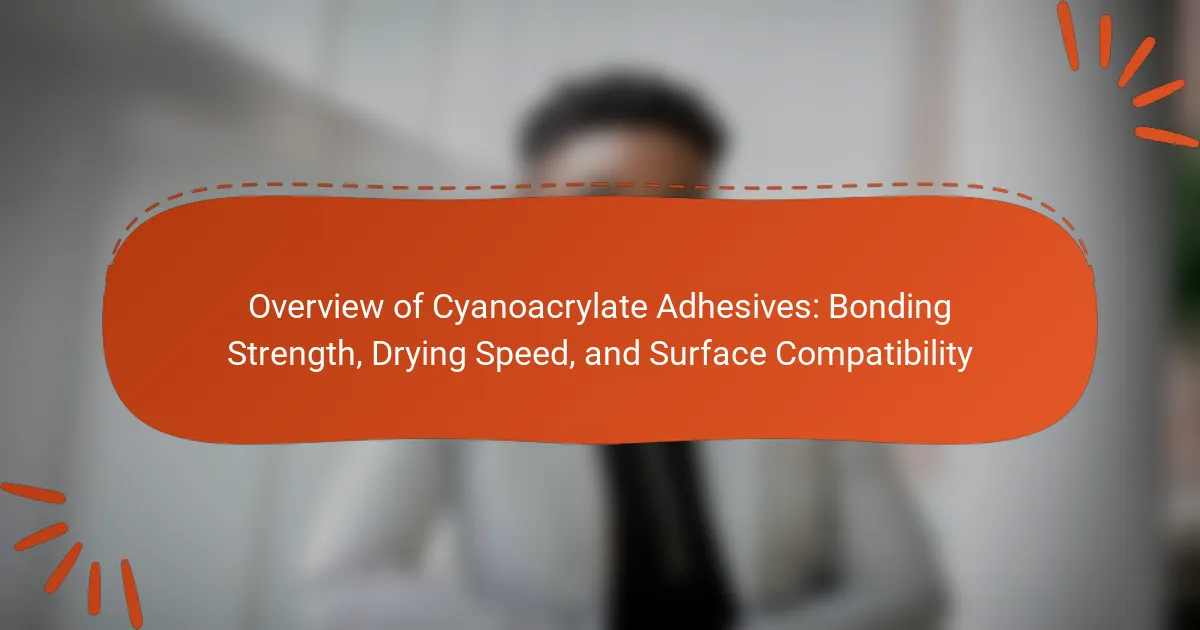Conductive adhesives are specialized materials designed to bond electronic components while facilitating electrical connectivity. This article examines the electrical properties and thermal conductivity of conductive adhesives, focusing on their composition, which often includes conductive fillers like silver or carbon. It also explores application techniques, highlighting the advantages of conductive adhesives over traditional soldering methods, such as flexibility and ease of use. Furthermore, the importance of these adhesives in modern electronics, particularly in flexible circuits and surface-mounted devices, is discussed, along with their ability to maintain conductivity under varying environmental conditions.

What are Conductive Adhesives?
Conductive adhesives are specialized adhesives that can conduct electricity. They are often used in electronic applications to bond components while providing electrical connectivity. These adhesives typically contain conductive fillers, such as silver or carbon, which enable the flow of electric current. Conductive adhesives can be thermosetting or thermoplastic, depending on their chemical composition. They offer advantages like flexibility and ease of application compared to traditional soldering. The use of conductive adhesives is essential in modern electronics, especially in flexible circuits and surface-mounted devices. Their effectiveness is supported by their ability to maintain conductivity under various environmental conditions.
How do Conductive Adhesives function?
Conductive adhesives function by creating a conductive pathway between electronic components. They contain metal particles or conductive polymers that facilitate electrical conductivity. When applied, these adhesives bond surfaces together while allowing electrical signals to pass through. The adhesive cures to form a solid connection, ensuring durability. The effectiveness depends on the type and concentration of conductive material used. For instance, silver-filled adhesives offer high conductivity compared to carbon-based alternatives. This property makes them suitable for applications in electronics, such as circuit board assembly and sensor attachment.
What materials are commonly used in Conductive Adhesives?
Conductive adhesives commonly use silver, copper, and carbon as primary materials. Silver is known for its excellent electrical conductivity. Copper is cost-effective and also provides good conductivity. Carbon-based materials, such as graphite or carbon nanotubes, are used for their flexibility and conductivity. Epoxy resins often serve as the adhesive matrix. These materials are selected based on their performance in specific applications. Conductive adhesives are widely used in electronics for bonding components. The choice of materials affects the adhesive’s electrical and thermal properties.
What role do conductive fillers play in these adhesives?
Conductive fillers enhance the electrical conductivity of adhesives. These fillers, often made from materials like silver, carbon, or copper, are mixed into the adhesive matrix. Their primary role is to create conductive pathways within the adhesive. This enables the adhesive to conduct electricity, making it suitable for electronic applications. Conductive fillers can also improve thermal conductivity. Enhanced thermal properties are crucial for heat dissipation in electronic devices. Studies show that the type and concentration of fillers directly influence the adhesive’s performance. For instance, a higher concentration of silver fillers can significantly increase conductivity.
What are the key electrical properties of Conductive Adhesives?
Conductive adhesives possess several key electrical properties. These include electrical conductivity, resistance, and dielectric strength. Electrical conductivity measures how well the adhesive allows electric current to flow. High conductivity is essential for effective electronic connections. Resistance indicates how much the adhesive opposes the flow of electric current. Lower resistance values are preferable for optimal performance. Dielectric strength refers to the adhesive’s ability to withstand electric fields without breaking down. High dielectric strength ensures reliability in various applications. These properties are critical for ensuring durability and efficiency in electronic devices.
How is electrical conductivity measured in Conductive Adhesives?
Electrical conductivity in conductive adhesives is measured using techniques such as four-point probe method and impedance spectroscopy. The four-point probe method involves placing four equally spaced electrodes on the adhesive surface. A current is passed through the outer electrodes while the voltage is measured across the inner electrodes. This setup minimizes the impact of contact resistance, providing a more accurate measurement of the adhesive’s conductivity.
Impedance spectroscopy analyzes the adhesive’s response to an alternating current over a range of frequencies. This method provides insights into the material’s electrical properties by measuring impedance at different frequencies. Both methods are widely accepted in the industry for their accuracy and reliability.
What factors influence the electrical properties of Conductive Adhesives?
The electrical properties of conductive adhesives are influenced by several key factors. These factors include the type of conductive filler used, the adhesive matrix, and the curing process. The choice of conductive filler, such as silver, copper, or carbon, directly affects conductivity levels. The adhesive matrix, whether epoxy or silicone-based, also plays a significant role in determining electrical performance. Additionally, the curing process impacts the final properties of the adhesive. For example, temperature and time during curing can enhance or diminish conductivity. Studies indicate that optimizing these factors can lead to improved electrical performance in applications, such as electronics and automotive industries.
What is the significance of thermal conductivity in Conductive Adhesives?
Thermal conductivity in conductive adhesives is crucial for heat dissipation in electronic applications. High thermal conductivity ensures efficient heat transfer away from heat-generating components. This property prevents overheating, which can lead to component failure. Conductive adhesives with optimal thermal conductivity enhance the reliability and longevity of electronic devices. For example, adhesives with thermal conductivities above 1 W/m·K are often preferred in high-performance applications. This characteristic allows for better thermal management in devices like LED lighting and power electronics. Thus, thermal conductivity is significant as it directly impacts the performance and durability of electronic assemblies.
How does thermal conductivity impact the performance of Conductive Adhesives?
Thermal conductivity significantly impacts the performance of conductive adhesives. High thermal conductivity allows for efficient heat dissipation in electronic applications. This property enhances the reliability and longevity of electronic components. Conversely, low thermal conductivity can lead to overheating and potential failure. Effective thermal management is crucial in maintaining optimal operating temperatures. Research indicates that conductive adhesives with thermal conductivity values above 1 W/mK are preferred in high-performance applications. This ensures that heat generated by components is effectively transferred away. Overall, thermal conductivity is a critical factor in the selection and application of conductive adhesives.
What materials enhance thermal conductivity in Conductive Adhesives?
Materials that enhance thermal conductivity in conductive adhesives include silver, copper, and aluminum. Silver is known for its high thermal and electrical conductivity. Copper also offers excellent thermal conductivity and is often used in various applications. Aluminum provides a balance of conductivity and cost-effectiveness. Fillers like graphite and carbon nanotubes can further improve thermal performance. Research indicates that incorporating these materials significantly increases the thermal conductivity of the adhesive matrix. For instance, silver-filled adhesives can achieve thermal conductivities exceeding 10 W/m·K.
How are Conductive Adhesives applied in various industries?
Conductive adhesives are applied in various industries for their unique electrical and thermal properties. In the electronics industry, they are used for bonding components like circuit boards and sensors. These adhesives provide reliable electrical connections while also serving as structural bonds. In the automotive sector, conductive adhesives are utilized for attaching sensors and electronic devices to ensure durability and conductivity. The aerospace industry employs them for lightweight bonding solutions in avionics and instrumentation. In medical devices, conductive adhesives facilitate the assembly of diagnostic equipment and wearable technologies. Their versatility allows for applications in consumer electronics, telecommunications, and renewable energy sectors as well. The global market for conductive adhesives was valued at approximately $2.5 billion in 2021, highlighting their widespread usage across multiple industries.
What application techniques are most effective for Conductive Adhesives?
Effective application techniques for conductive adhesives include screen printing, dispensing, and die-cutting. Screen printing allows for precise application on flat surfaces. Dispensing techniques, such as syringe or jet dispensing, enable controlled placement of adhesive. Die-cutting is useful for creating pre-shaped adhesive components. These methods ensure consistent thickness and coverage. Studies show that proper application enhances electrical performance and adhesion strength. For example, screen printing can achieve a line width of 100 microns, optimizing conductivity.
How do application techniques vary across different industries?
Application techniques for conductive adhesives vary significantly across industries. In electronics, precision application is crucial to ensure proper conductivity. Techniques such as screen printing and syringe dispensing are commonly used. In automotive manufacturing, bulk application methods like roll coating are preferred for efficiency. The aerospace sector often employs manual application for quality control in critical components. In medical devices, techniques must adhere to strict regulatory standards, often utilizing automated dispensing systems. Each industry adapts application methods based on material properties and performance requirements. For instance, the electronics industry prioritizes minimal waste and accuracy, while the automotive industry focuses on speed and scalability.
What challenges are associated with using Conductive Adhesives?
Conductive adhesives face several challenges in practical applications. One significant challenge is their curing time. Many conductive adhesives require extended curing periods to achieve optimal electrical conductivity. Additionally, the adhesion strength may not be as robust as traditional soldering methods. This can lead to reliability issues under stress or thermal cycling.
Another challenge is the variability in conductive fillers. Different fillers can affect the adhesive’s performance and conductivity. The choice of filler impacts the viscosity and application process. Furthermore, environmental factors also pose challenges. Conductive adhesives can be sensitive to humidity and temperature, affecting their performance.
Lastly, cost is a consideration. Conductive adhesives can be more expensive than conventional alternatives. This may limit their use in cost-sensitive applications. Overall, these challenges need to be addressed for effective use of conductive adhesives in various industries.
What common issues arise during the application of Conductive Adhesives?
Common issues during the application of conductive adhesives include improper surface preparation, which can lead to poor adhesion. Inadequate mixing of components may result in inconsistent electrical properties. Environmental factors such as humidity and temperature can affect curing times and performance. Incompatibility with substrates can cause delamination or failure of the bond. Additionally, air entrapment during application can create voids, compromising conductivity. These problems can lead to reduced reliability in electronic applications. Proper training and adherence to manufacturer guidelines can mitigate these issues.
How can these challenges be mitigated?
Challenges related to conductive adhesives can be mitigated through proper formulation and application techniques. Optimizing the adhesive composition enhances electrical performance and thermal conductivity. Employing precise application methods ensures uniform distribution and adhesion. Using appropriate curing processes improves bond strength and durability. Regular quality control checks can identify and address inconsistencies early. Research indicates that adjusting filler types and concentrations can significantly affect performance metrics. For instance, studies show that using silver nanoparticles can enhance conductivity while maintaining flexibility. Implementing these strategies can lead to improved reliability in applications.
What best practices should be followed when using Conductive Adhesives?
Use conductive adhesives in a clean and dry environment to ensure optimal adhesion. Proper surface preparation is crucial; clean surfaces remove contaminants that can affect bonding. Apply the adhesive evenly to avoid weak spots. Ensure correct curing time and temperature as specified by the manufacturer for maximum performance. Avoid excessive pressure during application, as it can lead to adhesive squeeze-out and reduced conductivity. Store adhesives according to the manufacturer’s guidelines to maintain their properties. Regularly check the adhesive’s expiration date to ensure effectiveness. Following these best practices enhances the reliability and performance of conductive adhesives in various applications.
How can users ensure optimal performance of Conductive Adhesives?
Users can ensure optimal performance of conductive adhesives by following specific application guidelines. First, they should clean the surfaces to remove contaminants. This promotes better adhesion and electrical conductivity. Next, users must mix the adhesive thoroughly according to manufacturer instructions. Proper mixing ensures uniform distribution of conductive fillers.
Additionally, applying the adhesive within the recommended temperature and humidity ranges is crucial. This helps achieve the desired curing conditions. Users should also allow adequate curing time before subjecting the adhesive to stress. This ensures full development of mechanical and electrical properties.
Finally, users should conduct regular inspections of the bonded joints. This helps identify any potential failures early on. Following these practices enhances the performance and longevity of conductive adhesives.
What troubleshooting tips are available for common problems with Conductive Adhesives?
Common problems with conductive adhesives include poor adhesion, uneven curing, and electrical performance issues. To troubleshoot poor adhesion, ensure surfaces are clean and free of contaminants. Use appropriate surface treatments like priming if necessary. For uneven curing, check the mixing ratio and application thickness. Follow the manufacturer’s guidelines for optimal curing conditions. If experiencing electrical performance issues, verify the adhesive’s conductivity specifications. Ensure the adhesive is fully cured before testing electrical properties. Adjust application techniques to ensure uniform distribution and proper contact between surfaces.
Conductive adhesives are specialized materials that provide electrical connectivity while bonding components in electronic applications. This article examines their electrical properties, including conductivity and resistance, as well as the significance of thermal conductivity in enhancing device performance. It also explores the materials used in these adhesives, the role of conductive fillers, and effective application techniques across various industries. Furthermore, the article addresses challenges associated with conductive adhesives and offers best practices for ensuring optimal performance and reliability.



